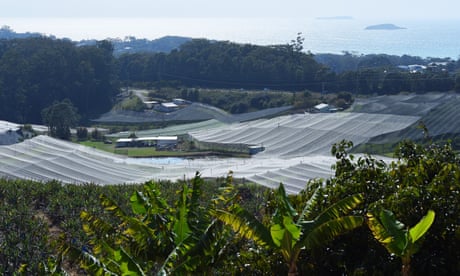- by foxnews
- 04 Apr 2025
Blueberry blues: how the cash crop is causing a contamination crisis in Coffs Harbour
Blueberry blues: how the cash crop is causing a contamination crisis in Coffs Harbour
- by theguardian
- 29 Sep 2022
- in news

In a region once famous for its Big Banana, blueberries are now the dominant crop. The berries account for $200m of the $250m agriculture industry in the Coffs Harbour district.
But with the change of use came concerns in this idyllic community on the New South Wales mid north coast about the environmental impact of pesticides and fertiliser runoff from these intensive farms. It may now be reaching a crisis, according to some scientists.
During heavy rain, water can be seen coursing down hills into creeks and rivers carrying sediment, high levels of fertiliser and other chemicals that are used to grow and protect blueberries.
The Coffs Harbour city council has been increasingly intervening to demand development applications when farms are set up or expanded in order to manage the problem.
The story of blueberries in the Coffs Harbour region is a salutary lesson in how pesticides and other agricultural chemicals are regulated.
Policing proper use of pesticides is split between the state environment and agriculture agencies.
There are few resources devoted to the issue, yet pesticides are by their nature some of our most toxic poisons, so their escape into waterways or other parts of the environment can have serious unintended consequences.
While regulators acknowledged and responded to the dangers of DDT and other organochlorines, it is now known that seemingly safer new-generation pesticides, such as the neonicotinoids, can have an impact on bees and aquatic life even at very small doses.
Only the most dramatic events seem to gain official attention.
In 2020 the Victorian Environment Protection Authority took action against a commercial flower grower in the coastal town of Torquay after nearby residents suffered vision impairment, sore throats, breathing difficulties, headaches, nausea and vomiting.Investigators found the chemical was being used to prepare ground for a new crop, but had been incorrectly applied and reacted with moist soil to produce methyl isothiocyanate, which is a hazardous gas.
Three people were taken to hospital by ambulance and a fourth transported himself. The grower was fined $70,000 without conviction.
The Victorian EPA said it did not have any statistics on other pesticide incidents and directed the Guardian to the agriculture department.
Over the past three years, there have been only two successful prosecutions of Pesticides Act offences in NSW. The EPA has also issued 30 advisory letters, 27 formal warnings, 30 official cautions, three clean-up actions and one prevention notice.
It took more than 130 incident reports from the community and research by Southern Cross University in association with the Coffs Harbour council in 2017-18 to get official action over the impacts of the rapid expansion of blueberry farms and other intensive horticulture in the region.
Researchers found that nitrogen oxide levels in creeks feeding into the Hearnes Lake catchment were up to 695 times higher during high rainfall events than in dry weather and levels were as high as the worst rivers in China. This was attributed to fertiliser runoff.
Hearnes Lake is particularly important because it serves as a nursery for the nearby Solitary Islands marine park, which in turn nurtures the abundant seafood of the region.
Finally the Natural Resources Access Regulator stepped in on water use issues and the EPA undertook inspections and testing around Hearnes Lake, focusing on the impact of pesticides and fertilisers.
In October 2021 it issued a $7,500 fine and a caution to a blueberry farmer at Woolgoolga over pesticide pollution and storage. It has also put out guidance notes in an effort to raise standards of pesticide use among blueberry growers.
Even tiny amounts of imidacloprid can be highly toxic to aquatic life.
Southern Cross University marine science professor Kirsten Benkendorff said her research has found residues of neonicotinoids above the safe residue limits in prawn flesh and in water in Hearnes Lake.
Pesticides had also been found in oysters and while it is causing stress, they seem to be more resistant, she said.
Further up the coast in the Richmond River, Benkendorff has detected high levels of atrazine, a potent endocrine disrupter that affects sexual development and has been linked to cancer. It is banned in Europe but still used on sugar cane and other crops in Australia.
The EPA announced in May it is targeting pesticide use in the Hearnes Lake catchment.
One of the biggest problems for the regulation of pesticides in the environment is that the burden of proof falls on academics and the community.
Benkendorff said it cost more than $300 for each of her samples to be tested for pesticides, putting it beyond the reach of many communities. Separate tests were needed to detect glyphosate (sold as Roundup or Zero), one of the most common herbicides in use in Australia.
Matt Landos, a veterinarian and honorary lecturer in aquatic health at the University of Sydney, said the environment protection authorities are often reluctant to follow up on allegations of spray drift or concerns about environmental pollution because of the difficulty in getting a successful prosecution.
Spray drift incidents need to be investigated quickly and people reporting them often faced an almost insurmountable burden of establishing who was spraying and where the drift came from, Landos said.
The NSW EPA appeared to confirm his concerns.
- by foxnews
- descember 09, 2016
'I traveled for an entire year for free - and saved $15K'
Hailey Learmonth explored Australia without paying rent, thanks to pet sitting. She saved $15,000, lived on farms, and embraced remote work to travel on a budget.
read more


